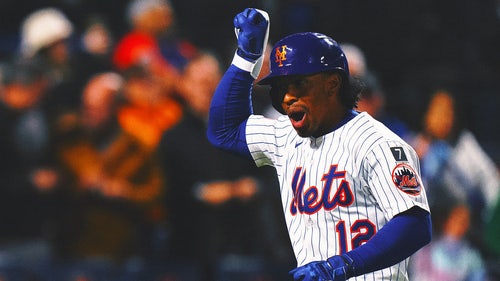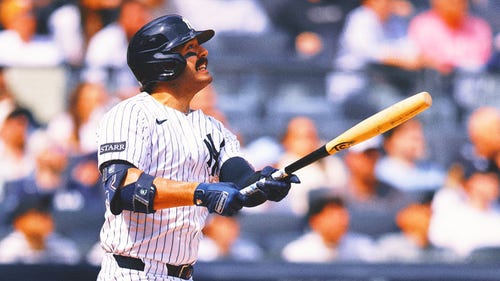
Let's talk about Colon's marvelous hitting for a minute
With the news that Bartolo Colon signed a one-year, $7.25 million deal with the New York Mets, we once again have a chance to talk about the skill set of one of the most beloved players in baseball. Add onto that the fact that his new contract includes a $50,000 bonus if he wins a Silver Slugger Award, and we're perfectly set up to talk about the most loved aspect of one of the most loved player's games: his performance at the plate. Any chance to talk about Colon is a good one. A chance to find a new angle on Colon's hitting is the El Dorado of baseball writing.
The search for that city of gold could start in any number of places. Especially over the past few years, we've seen highlights of Colon's exploits with the bat, from his helmet doing everything it could to escape the perch atop his head, to him legging out infield singles. He's a human highlight reel when he gets a piece of maple in his hands, and it would be very easy to simply embed a few videos of his at-bats here and call it a day (I've linked to them instead).
Let's dig a little deeper, however. One question we can answer is where Colon ranks among all pitchers who have accrued (or endured) their fair share of plate appearances. We all know of the jokes about him at the plate, and the at-bats in which he simply seems to have better things to do. But is Bartolo really one of the worst-hitting pitchers of all time?
To answer that, I've pulled data going back to 1961 for all plate appearances by pitchers. Colon has 237 PAs over the course of 18 seasons, so let's exclude all pitchers who had under 225. One quick note before we go any further: with this limited number of plate appearances (and them occurring after long intervals), there are some limitations on how confident we are in judging how adept these pitchers were with the bat.
Confidence rises in the accuracy of statistics such as On Base Percentage as the number of plate appearances increases, but we also can understand a lot from the sample size we're using. Pitchers hitting is a fun topic, and we probably shouldn't be too worried about whether this study is exceedingly accurate or simply accurate enough for our purposes -- which it is.
With that said, I've plotted the 200 worst hitting pitchers from 1961-2015 by On Base Plus Slugging+ (OPS+), a stat which compares a hitter's production to the league average of the years in which they played. While it doesn't compensate for the fact that baseball has become more specialized in recent years -- making pitchers worse at hitting in general -- it does introduce some year-to-year stabilization. OPS+ adjusts for the league and ballparks each pitcher batted in, so it helps put everyone on a more even playing field. Let's take a look at an interactive chart of our 200 pitchers mapped by OPS+ and plate appearances, with Bartolo highlighted (mouse over each dot to see the details of each player):
Is Colon one of the worst-hitting pitchers of the past 50+ years? Yes, he is. By OPS+, he ranks 13th worst among pitchers with at least 225 plate appearances at -44, meaning he has been 144 percent worse than the league average hitter during his career. He has a .202 OPS over 18 MLB seasons with a 47.7 percent strikeout rate, and he is one of only two pitchers among these 200 who have never walked in his career (the other is Tracy Stallard).
So yes, Bartolo has been historically bad at hitting. But the news isn't all terrible: he took steps to improve his at-bats last season, and his teammates on the Mets say that no other pitcher worked harder in the batting cage last year. That work showed in his rate and counting stats, as he posted a .150 OBP, drove in four runs, and smacked the second extra base hit of his career:
If there is one lesson to be taken from Colon in this video, it's that running is overrated. He also showed better plate discipline and pitch identification during 2015. Using Baseball Savant, we can work out the rates of pitches he swung at inside (Z-Swing%) and outside (O-Swing%) of the strike zone, as well as to calculate his overall contact numbers. Take a look at the comparison of his 2014 season at the plate vs. 2015:
| Season | O-Swing% | Z-Swing% | Contact% |
| 2014 | 24.1% | 37.3% | 64.7% |
| 2015 | 20.4% | 36.5% | 72.6% |
These seasons are obviously really small sample sizes, so take them with a healthy grain of salt, but hey -- improvement! Swinging at fewer pitches outside of the zone and making a lot more contact is never a bad thing. There were real reasons behind Bartolo's improved statistics at the plate this year, and he made himself an average hitter by OPS when compared to the other pitchers in baseball. Considering where he was not too long ago, we should consider that a big step forward.
We'll always have memories of Colon carrying his bat to first base, and losing his helmet on swings, and walking to second base on what almost certainly could have been a triple. We'll almost certainly have more of those in the future, so long as he keeps playing and batting. But that's probably not who he wants to be, and at 42 years old, he's working to improve an aspect of his game that has been historically terrible. That's admirable.
The Mets just decided that we get to have at least one more year of Bartolo, and one more year of his at-bats; in the midst of winter, that's one of the best presents we could ask for.







